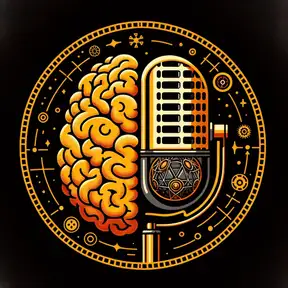Busting Brain Busters: Unraveling Popular Psychology Myths
Debunking Psychology Myths: From Brain Function to Vaccines
In this episode of PsyberSpace, host Leslie Poston critically examines several long-standing psychology myths and their impacts. The discussion covers misconceptions such as the left-brained/right-brained theory, the myth that we use only 10% of our brain, the idea that opposites attract in relationships, and the belief that venting anger is beneficial. Further myths debunked include the notion that memory functions like a video camera, the causation of hyperactivity in children by sugar, subliminal messages controlling behavior, the Mozart effect's impact on intelligence, and the debunked link between vaccines and autism. Throughout, Leslie explains how these myths gained traction and their real-world consequences in education, healthcare, and personal beliefs.
00:00 Welcome to PsyberSpace
02:09 Debunking the Left-Brain Right-Brain Myth
04:50 The 10% Brain Usage Myth
07:01 Do Opposites Really Attract?
09:07 The Myth of Venting Anger
11:29 Memory: Not a Video Camera
13:35 Misunderstandings About DID and Schizophrenia
17:13 Sugar and Hyperactivity in Children
19:16 The Truth About Subliminal Messages
21:01 The Mozart Effect: Music and Intelligence
22:57 The Dangerous Myth Linking Vaccines and Autism
24:50 Conclusion and Further Exploration
References
Aamodt, M. G. (2008). Reducing misconceptions and false beliefs in police and criminal psychology. Criminal Justice and Behavior, 35(10), 1231-1240.
In this episode of PsyberSpace, host Leslie Poston critically examines several long-standing psychology myths and their impacts. The discussion covers misconceptions such as the left-brained/right-brained theory, the myth that we use only 10% of our brain, the idea that opposites attract in relationships, and the belief that venting anger is beneficial. Further myths debunked include the notion that memory functions like a video camera, the causation of hyperactivity in children by sugar, subliminal messages controlling behavior, the Mozart effect's impact on intelligence, and the debunked link between vaccines and autism. Throughout, Leslie explains how these myths gained traction and their real-world consequences in education, healthcare, and personal beliefs.
00:00 Welcome to PsyberSpace
02:09 Debunking the Left-Brain Right-Brain Myth
04:50 The 10% Brain Usage Myth
07:01 Do Opposites Really Attract?
09:07 The Myth of Venting Anger
11:29 Memory: Not a Video Camera
13:35 Misunderstandings About DID and Schizophrenia
17:13 Sugar and Hyperactivity in Children
19:16 The Truth About Subliminal Messages
21:01 The Mozart Effect: Music and Intelligence
22:57 The Dangerous Myth Linking Vaccines and Autism
24:50 Conclusion and Further Exploration
References
Aamodt, M. G. (2008). Reducing misconceptions and false beliefs in police and criminal psychology. Criminal Justice and Behavior, 35(10), 1231-1240.
Aguinis, H., Pierce, C. A., Bosco, F. A., Dalton, D. R., & Dalton, C. M. (2011). Debunking myths and urban legends about meta-analysis. Organizational Research Methods, 14(2), 306-331.
Dawes, R. M. (1994). House of cards: Psychology and psychotherapy built on myth. Choice Reviews Online, 32(1), 32-1228.
Eliot, L. (2011). The trouble with sex differences. Neuron, 72(6), 895-898.
Furnham, A. (2018). Myths and misconceptions in developmental and neuro-psychology. Psychology, 9(2), 249-259.
Furnham, A., & Hughes, D. J. (2014). Myths and misconceptions in popular psychology. Teaching of Psychology, 41(3), 214-221.
Gaze, C. M. (2014). Popular psychological myths: A comparison of students' beliefs across the psychology major. Journal of the Scholarship of Teaching and Learning, 14(2), 46-60.
Geake, J. (2008). Neuromythologies in education. Educational Research, 50(2), 123-133.
Grospietsch, F., & Lins, I. (2021). Review on the prevalence and persistence of neuromyths in education – Where we stand and what is still needed. Frontiers in Education, 6, 665752.
Higbee, K. L., & Clay, S. L. (1998). College students' beliefs in the ten-percent myth. The Journal of Psychology, 132(5), 469-476.
Hines, T. (1987). Left brain/right brain mythology and implications for management and training. Academy of Management Review, 12(4), 600-606.
Lewandowsky, S., Ecker, U. K. H., Seifert, C. M., Schwarz, N., & Cook, J. (2012). Misinformation and its correction: Continued influence and successful debiasing. Psychological Science in the Public Interest, 13(3), 106-131.
Macdonald, K., Germine, L., Anderson, A., Christodoulou, J., & McGrath, L. M. (2017). Dispelling the myth: Training in education or neuroscience decreases but does not eliminate beliefs in neuromyths. Frontiers in Psychology, 8, 1314.
Meinz, E. J., Tennison, W. A., & Dominguez, W. A. (2022). Who believes the "50 great myths of psychology"? Teaching of Psychology, 49(2), 121-131.
Melnikoff, D. E., & Bargh, J. A. (2018). The mythical number two. Trends in Cognitive Sciences, 22(4), 280-293.
Scudellari, M. (2015). The science myths that will not die. Nature, 528(7582), 322-325.
Schwarz, N., Newman, E. J., & Leach, W. (2016). Making the truth stick & the myths fade: Lessons from cognitive psychology. Behavioral Science & Policy, 2(1), 85-95.
Simons, D. J., & Chabris, C. F. (2011). What people believe about how memory works: A representative survey of the U.S. population. PLoS ONE, 6(8), e22757.
Standing, L. G., & Huber, H. (2003). Do psychology courses reduce belief in psychological myths? Social Behavior and Personality, 31(6), 585-592.
Waterhouse, L. (2006). Multiple intelligences, the Mozart effect, and emotional intelligence: A critical review. Educational Psychologist, 41(4), 207-225.
★ Support this podcast ★
Creators and Guests


